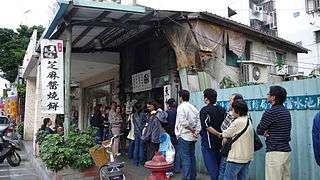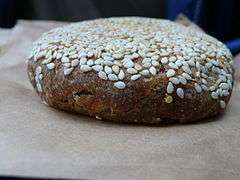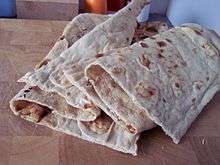Shaobing
|
Typical shaobing. The round shaobing on the right are sweet and filled with sugar and the long shaobing on the left are savory and salted. | |
| Alternative names | Huoshao |
|---|---|
| Type | Flatbread |
| Course | Breakfast |
| Place of origin | China |
| Serving temperature | breakfast |
|
| |
| Shaobing | |||||||||||||||||
| Traditional Chinese | 燒餅 | ||||||||||||||||
|---|---|---|---|---|---|---|---|---|---|---|---|---|---|---|---|---|---|
| Simplified Chinese | 烧饼 | ||||||||||||||||
| Literal meaning | roasted pastry | ||||||||||||||||
| |||||||||||||||||
| Huoshao | |||||||||||||||||
| Traditional Chinese | 火燒 | ||||||||||||||||
| Simplified Chinese | 火烧 | ||||||||||||||||
| Literal meaning | fire roasted | ||||||||||||||||
| |||||||||||||||||
Shaobing (shāo bǐng), also written shao bing or sao bing,[1][2][3][4][5][6][7][8][9][10][11][12] is a type of baked, unleavened, layered flatbread in Chinese cuisine. Shaobing can be made with or without stuffing, and with or without sesame on top. Shaobing contains a variety of stuffings that can be grouped into two main flavors: savory or sweet. Some common stuffings include red bean paste, black sesame paste, stir-fried mung beans with egg and tofu, braised beef, smoked meat,[13] or beef or pork with spices.[14]
Shaobing is not very well known in southern China, unlike other northern dishes like mantou, baozi, and youtiao. Some unique varieties of shaobing can be completely unheard of in the south. Different types of shaobing are often associated with certain cities and towns.
Shaobing is a common breakfast item. Filled shaobing are usually eaten with soy milk and tea, while unfilled ones are usually eaten with steamed eggs or a breakfast meat dish. In the Mandarin cuisine tradition, shaobing are served with hot pot (huǒguō) in winter or soy milk.
Miscellaneous
Chinese legends claim that the roasted, flat shaobing was brought back from the Xiyu (the Western Regions, a name for Central Asia) by the Han dynasty General Ban Chao, and that it was originally known as hubing (胡餅, lit. "barbarian pastry"). The shaobing is believed to be descended from the hubing.[15] Shaobing is believed to be related to the Persian and Central Asian naan and the Near Eastern pita.[16][17][18][19] Foreign westerners made and sold sesame cakes in China during the Tang dynasty.[20]
Liu Bowen was one of the most famous scholars of the Ming dynasty. He presented a cryptic lyrical song titled "Shaobing Song" (燒餅歌) to the Zhu Yuanzhang emperor. The song supposedly predicted the future of China.[21][22][23]
Image gallery
Taiwanese sesame paste shaobing:
See also
References
- ↑ "Sao Bing". FoodMayhem. 2008-04-01. Retrieved 2013-05-14.
- ↑ "Hua Juan and Sao Bing". Baking With Em&M. 2011-03-24. Retrieved 2013-05-15.
- ↑ Westways. 61. Automobile Club of Southern California. 1969. p. 57. Retrieved 24 April 2014.
- ↑ Hou, Helena (1977). Return to Peking. China Publishing Company. pp. 44, 47. Retrieved 24 April 2014.
- ↑ Common Ground. 4. American Universities Field Staff. 1978. p. 67. Retrieved 24 April 2014.
- ↑ Liu, Jennifer Li-chia (2004). Connections II: A Cognitive Approach to Intermediate Chinese, Volume 2. Chinese in context language learning series (illustrated ed.). Indiana University Press. p. 333. ISBN 0-253-21665-6. Retrieved 24 April 2014.
- ↑ Food Facts, Volumes 1-14. Wheat Flour Institute. 1931. Retrieved 24 April 2014.
- ↑ Hollister, Margaret (2010). Inheriting China: A Memoir (illustrated ed.). Lulu.com. p. 118. ISBN 0-578-07069-3. Retrieved 24 April 2014.
- ↑ Ravenholt, Betty; Ravenholt, R. t. (2009). West Over the Seas to the Orient: Ravenholt Family, Formative Years, Life Adventures. Trafford Publishing. p. 298. ISBN 1-4269-1870-4. Retrieved 24 April 2014.
- ↑ Fu Pei-Mei (2010). Pei-Mei's Chinese Cookbook. 1. Translated by Paul Eng. Contributor Martha Dahlen. askmar publishing. ISBN 1-935842-04-8. Retrieved 24 April 2014. horizontal tab character in
|others=at position 14 (help) - ↑ Fu Pei Mei (2010). Pei-Mei's Chinese Cookbook. 2. askmar publishing. ISBN 1-935842-05-6. Retrieved 24 April 2014.
- ↑ Shurtleff, William; Aoyagi, Akiko (2009). History of Miso, Soybean Jiang (China), Jang (Korea) and Tauco (Indonesia) (200 BC-2009). Soyinfo Center. p. 329. ISBN 1-928914-22-5. Retrieved 24 April 2014.
- ↑ Kraig, Bruce, ed. (2013). Street Food Around the World: An Encyclopedia of Food and Culture. ABC-CLIO. p. 92. ISBN 1-59884-955-7. Retrieved 24 April 2014.
- ↑ Church, Marguerite Chien (2002). Adopted, the Chinese Way. Infinity Publishing. p. 127. ISBN 0-7414-1224-1. Retrieved 24 April 2014.
- ↑ Huang, H. T. (2000). Fermentations and Food Science, Volume 6. Cambridge University Press. p. 474. ISBN 0521652707. Retrieved 24 April 2014.
- ↑ Anderson (1988), p. 143, 144, 218.
- ↑ Simoons, Frederick J. (1990). Food in China: A Cultural and Historical Inquiry. CRC Press. p. 89. ISBN 084938804X. Retrieved 24 April 2014.
- ↑ Free China Review, Volume 45, Issues 7-12. W.Y. Tsao. 1995. p. 66. Retrieved 24 April 2014.
- ↑ Charles Holcombe (January 2001). The Genesis of East Asia: 221 B.C. - A.D. 907. University of Hawaii Press. pp. 129–. ISBN 978-0-8248-2465-5.
- ↑ Schafer, Edward H. (1963). The Golden Peaches of Samarkand: A Study of Tʻang Exotics (illustrated, reprint, revised ed.). University of California Press. p. 29. Retrieved 24 April 2014.
- ↑ Windridge, Charles. [1999] (2003) Tong Sing The Chinese Book of Wisdom. Kyle Cathie Limited. ISBN 0-7607-4535-8. pg 124-125.
- ↑ Ji, Liu. [2004] (2004) 燒餅歌與推背圖. Bai Shan Shu Fang Publishing Company. ISBN 986-7769-00-7.
- ↑ HK geocities. "HK geocities." 燒餅歌. Retrieved on 2008-09-19.




